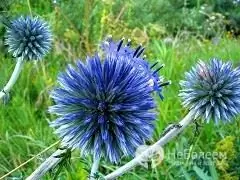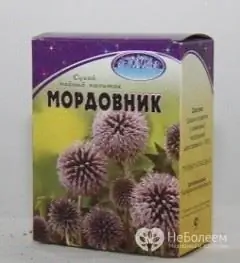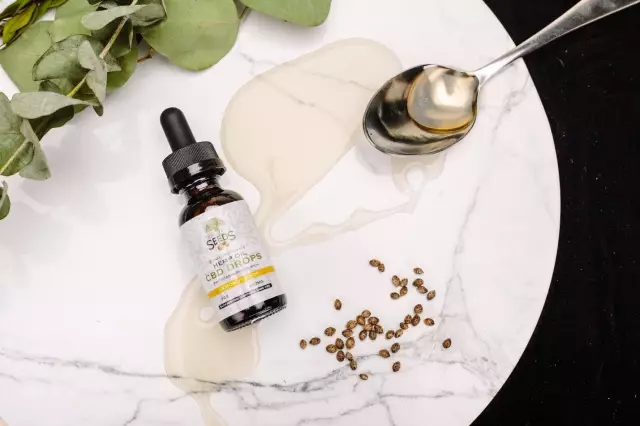- Author Rachel Wainwright [email protected].
- Public 2023-12-15 07:39.
- Last modified 2025-11-02 20:14.
Mordovnik
Instructions for use:
- 1. Description
- 2. Chemical composition
- 3. Application in medicine
- 4. Contraindications and warnings

Mordovnik is a herb belonging to the Astrov family.
Mordovnik description
The plant reaches a height of 1.5 m, has a taproot thick low-branched root. The leaves are deeply divided, alternate, slightly cobweb or glabrous, dark green above. Basal and lower stem leaves are petiolate, the rest are sessile.
Inflorescences are spherical, large, multi-flowered heads, located singly at the ends of the stem.
The plant grows in Europe, North Africa, Central Asia and the South Urals. Prefers rocky slopes, steppes, roadsides, sand and coastal pebbles.
Mordovnik ordinary is the strongest honey plant. About 1 ton of honey can be harvested from 1 hectare.
For medicinal purposes, the seeds of the muzzle are used.
The chemical composition of the muzzle
The seeds of the cormorant contain alkaloids (mainly Echinopsin - 2%). Also there are fatty oils, triterpenoids, flavonoids, tannins, ascorbic acid, rubber, saponins, higher aliphatic hydrocarbons.
The use of a scabbard in medicine
Asthenia and paresis have been treated with the plant since ancient times. Dioscorides, a famous ancient healer, mentioned this plant more than once in his writings.
At present, the mordovnik has found its application in pharmacology and scientific medicine.
Pharmacists noticed this plant back in 1900, when they found echinopsin in it, which is similar in its action to strychnine. In those days, echinopsin was not yet used in practical medicine. And so, in the 50s of the last century, drugs began to be made from echinopsin.
In official medicine, Echinopsin nitrate, a solution for injection and for internal use, was used. Echinopsin is able to stimulate reflex excitability of the spinal cord, resulting in increased muscle tone and motor activity. It also exacerbates the reaction to painful pathogens. It has been proven that Echinopsin enhances the processes of excitability and conduction in nerve endings by increasing their action potential and increasing the permeability of cell membranes.
It was noticed that Echinopsin lowers blood pressure and dilates blood vessels, increases the frequency and amplitude of the heart rate.
In therapy, the use of muzzle and echinopsin was quite wide. Treatment with Echinopsin preparations was carried out for muscle atrophies, multiple sclerosis, myasthenia gravis, and peripheral nerve lesions. It was used to eliminate the consequences of radiation sickness and as a tonic and tonic.
In 81 of the last century, drugs based on echinopsin were excluded from the number of used drugs due to the appearance of more effective drugs.

Mordovnik has also found application in folk medicine. Here it is used for exhaustion, to relieve headaches, to relieve epileptic seizures. Mordovian seeds are used as a diuretic. With arterial hypertension and heart disease, they are taken orally.
The inflorescences of the plant are part of the collection taken for gastroenteritis, malaria, pleurisy.
Some parts of the muzzle are used to treat liver echinococcosis and infectious hepatitis.
Outwardly, the plant is prescribed for skin diseases.
Contraindications and warnings
Mordovnik is a poisonous plant, its toxicological properties have not yet been fully studied. Therefore, it should be used only under the strict supervision of doctors.
Information about the drug is generalized, provided for informational purposes only and does not replace the official instructions. Self-medication is hazardous to health!






